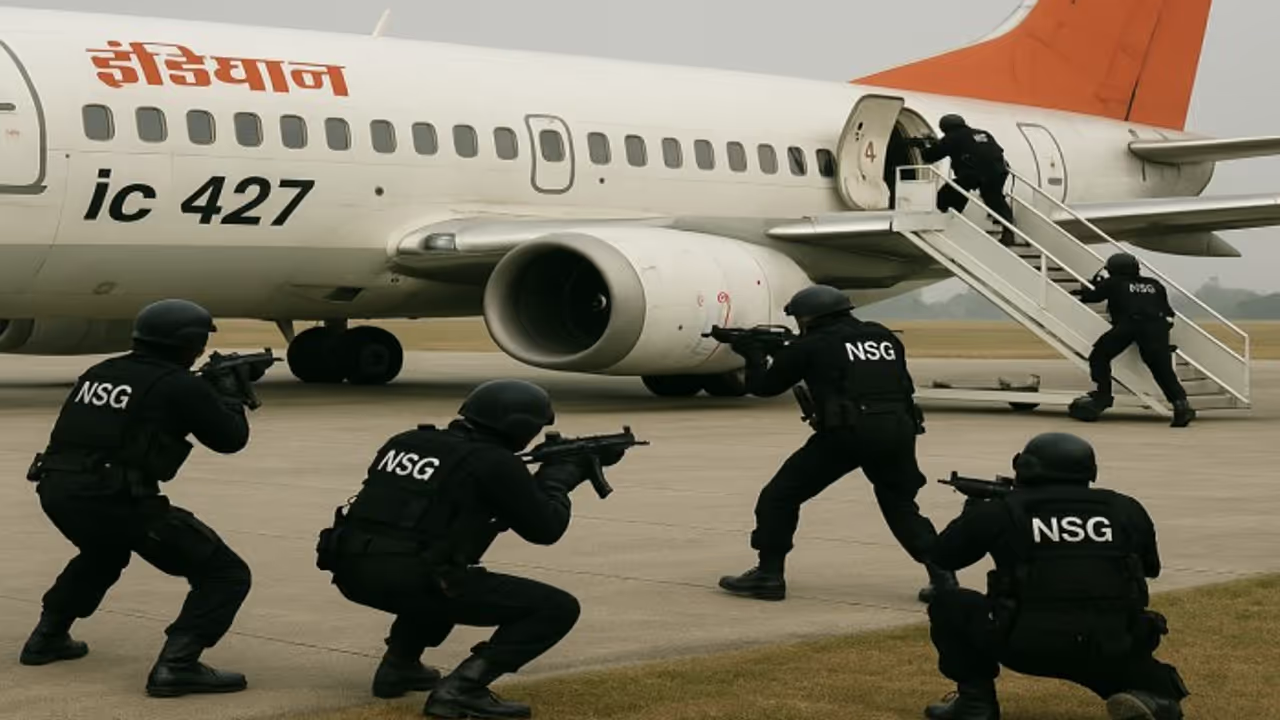The lone hijacker, Mohammad Yousuf, was killed within 5 minutes of commandos entering the plane, before he could react and harm any of the hostages.
(AI-generated cover image used for representational purposes only)

Indian Airlines Flight 427, a domestic passenger flight of the Indian Airlines between Srinagar Airport and the Delhi-Indira Gandhi International Airport, was involved in an aircraft hijacking that took place in India between 24 and 25 April 1993. Commandos from the National Security Guard (NSG) rescued all 141 hostages of the Indian Airlines Boeing 737, on the ground at Amritsar airport (where it was forced to land after being denied overflight permission by Pakistan to reach Kabul).
The lone hijacker, Mohammad Yousuf, was killed within 5 minutes of commandos entering the plane, before he could react and harm any of the hostages. The rescue was code-named Operation Ashwamedh.
The mission, dubbed Operation Ashwamedh, was the first real test for the German-trained anti-hijacking squad of the elite NSG. It infact, made it to the Limca Book of Records as the “fastest commando operation” ever conducted on Indian soil.
The Hijacking:
Tension at 30,000 Feet Indian Airlines Flight IC 427, operating from Srinagar to Delhi with a stopover at Jammu, was commandeered midair by a lone terrorist, Mohammed Yasin Malik of the Jammu and Kashmir Liberation Front (JKLF).
Indian Airlines Flight IC427 departed Delhi at 13:57 for Srinagar with 6 crew members and 135 passengers on board. During the flight, a passenger, who first identified himself as Syed Salauddin, claimed that he was carrying pistols and a hand grenade, and asked the plane to be flown to Kabul. At 14:43, the Delhi Air Traffic Control received a message that the plane had been hijacked and was heading for Kabul in Afghanistan.
The Lahore Air Traffic Control refused to permit the plane to enter the Pakistani airspace, and the flight returned to India after circling over Lahore. Eventually, the plane landed at Amritsar in India at 15:20. The hijacker demanded refueling, and again asked for the plane to be flown to Kabul. The Crisis Management Group (CMG) at the Cabinet Secretariat of India and the Central Committee at Delhi Airport responded to the situation.
The Deputy Commissioner and the Senior Superintendent of Police of the Amritsar district were sent to the airport to negotiate with the hijacker. At 18:00, the Director General of Punjab Police arrived in Amrtisar, and took charge of the negotiation process. However, the hijacker remained adamant on his demand, and even fired a warning shot which pierced through the body of the aircraft.
Lightning Strike
Once IC 427 touched down, the government made a swift decision — no negotiations, no delays. The NSG commandos, clad in black and bristling with precision, received the green signal. They stormed the aircraft through the emergency doors and neutralized Malik within minutes. Not a single civilian was harmed.
The entire operation — from breach to capture — was over in just five minutes.
How it stood apart from the IC 814 Kandahar crisis (1999)
The events of 1993 and the 1999 IC 814 Kandahar hijacking stand in stark contrast. Whereas IC 427 saw decisive military action on Indian soil, the hijacking of IC 814 exposed diplomatic paralysis and lack of preparedness.
Location and Control: In 1993, the aircraft remained within India’s territorial boundary, giving the government full control over the situation. In 1999, IC 814 was flown to Kandahar, Afghanistan — beyond India's immediate reach.
Having used NSG commandos in 1993, and that too in Amritsar, many people wondered if that couldn't have been replicated in the case of the seven-day-long Kandahar hijack.
AS Dulat, then chief of RAW, India's external intelligence agency, called the failure to prevent IC 814 from leaving Amritsar a "goof-up". But, the criticisms and concerns don't look to be entirely baseless, given that Punjab Police reportedly requested permission from the Centre to deploy its counter-terror commandos to tackle the IC 814 hijacking. But, the Central government preferred to have the elite NSG commandos flown to Amritsar.
The 45 minutes in Amritsar passed in a stalemate, and the opportunity was lost.
Yes, the circumstances of 1999 were different from those in 1993, but not all.


